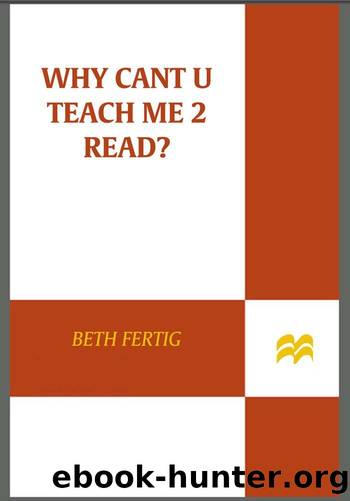Why cant U teach me 2 read?: Three Students and a Mayor Put Our Schools to the Test by Beth Fertig

Author:Beth Fertig [Fertig, Beth]
Language: eng
Format: azw3
ISBN: 9780374299057
Publisher: Farrar, Straus and Giroux
Published: 2009-09-14T16:00:00+00:00
FOURTEEN
Learning to Rhyme
Yamilka’s classes at the Fisher Landau Center for the Treatment of Learning Disabilities in the Bronx started in January, and it wasn’t long before her speech therapist made a remarkable discovery.
“She can’t hear rhymes very well,” said Nancy Tarshis, the center’s supervisor of speech and language services. “If you said, ‘Ted and Fred—does that rhyme?’ her accuracy rate is about sixty or seventy percent.”
Tarshis has been at Fisher Landau since she started working on a master’s degree in speech therapy at Teachers College in 1991. She previously taught deaf and hearing-impaired students. Her cramped office has a tiny children’s table and matching red-and-yellow chairs that look like they came straight from McDonaldland. There are board games and toys piled up on the shelves. Tarshis was working solely with children until Fisher Landau got a new grant, enabling it to serve adults who come for language therapy. This was good timing for Yamilka, and Tarshis is intrigued by her new student.
“She processes sounds poorly. Very poorly,” she states. “And when I say ‘processes sounds,’ I’m actually talking about the sounds. She’s language impaired in two languages, I would guess.
“Phonemic awareness is one of the things that underlie reading. The ability to hear rhyme, the ability to recognize the first sound, the last sound, to segment words into syllables.”
But Yamilka often can’t hear those discrete parts of a word. Tarshis gave her the same type of test she would give a child. She asked her if “cat” and “hat” rhyme and Yamilka said yes. She could hear that “cop” and “book” did not rhyme, and neither did “dog” and “top.” But when asked if “cook” and “book” rhyme, Yamilka said no. “So then I got concerned,” said Tarshis. “At twenty-four she ought not to get anything wrong. So then I decided to add a couple more. Do ‘seat’ and ‘beat’ rhyme? No. Do ‘rat’ and ‘fit’ rhyme? No. So she got two wrong. That percentile is not great—she should be at one hundred percent.” Tarshis says Yamilka should have been able to hear these similarities and differences regardless of whether she was speaking in English or Spanish.
Yamilka’s issue wasn’t unusual. Many children have phonological problems. Think of the cartoon character Elmer Fudd saying “vewy” instead of “very” and “wabbit” instead of “rabbit.” Some children substitute t for k (like Eddie Murphy saying “Otay” as he impersonated Buckwheat from the show Our Gang). They also say t for s, as in toup for soup. Young children make those errors until they get the hang of the sounds, but some still can’t hear the mistakes when they’re ready for school. Of those students, Tarshis says, about 30 percent eventually improve on their own. Another 30 percent need therapy but get better by kindergarten. And the rest will have lifelong learning issues because their phonemic awareness is so poor.
There are many experts who believe all reading disabilities are fundamentally rooted in language disorders, and that having one of these disabilities makes you more likely to have others.
Download
This site does not store any files on its server. We only index and link to content provided by other sites. Please contact the content providers to delete copyright contents if any and email us, we'll remove relevant links or contents immediately.
| Arts & Humanities | Health |
| Language Arts | Library Skills |
| Mathematics | Reading & Phonics |
| Science & Technology | Social Studies |
The Art of Coaching Workbook by Elena Aguilar(48065)
Trainspotting by Irvine Welsh(20055)
Twilight of the Idols With the Antichrist and Ecce Homo by Friedrich Nietzsche(17706)
Fangirl by Rainbow Rowell(7834)
Periodization Training for Sports by Tudor Bompa(7328)
Change Your Questions, Change Your Life by Marilee Adams(6641)
This Is How You Lose Her by Junot Diaz(5773)
Grit by Angela Duckworth(4737)
Red Sparrow by Jason Matthews(4666)
Asking the Right Questions: A Guide to Critical Thinking by M. Neil Browne & Stuart M. Keeley(4576)
Paper Towns by Green John(4169)
Room 212 by Kate Stewart(4107)
Ken Follett - World without end by Ken Follett(3972)
The Sports Rules Book by Human Kinetics(3588)
Housekeeping by Marilynne Robinson(3401)
The Motorcycle Diaries by Ernesto Che Guevara(3332)
Introduction to Kinesiology by Shirl J. Hoffman(3301)
Exercise Technique Manual for Resistance Training by National Strength & Conditioning Association(3292)
Double Down (Diary of a Wimpy Kid Book 11) by Jeff Kinney(3272)
